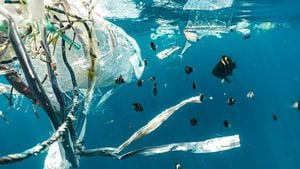Recently, scientists uncovered one of the most astonishing marine discoveries of the year: a massive coral structure off the coast of the Solomon Islands, which is said to be so grand it’s visible from space. This coral, which measures about the size of two basketball courts combined, not only breaks records for its size but also offers insights about the resilience of coral species amid the pressing challenges posed by climate change.
This colossal coral, scientifically classified as Pavona clavus, was discovered during an expedition by researchers from the National Geographic Pristine Seas project. Reuters reported exciting details about the find, noting it is nearly three times larger than the previous record holder, marking a significant moment for marine biology and coral research.
The remarkable feature of this discovery is not just its size—measuring approximately 34 meters wide and 32 meters long—but its complex biological makeup. This gigantic entity includes nearly one billion individual animals known as polyps, which collectively function as one organism. The polyps are genetically identical, working together much like cells within a singular body.
Corals like Pavona clavus are known to build massive structures through symbiotic relationships with other sea organisms, and they’re usually formed over centuries. Given the coral's large size coupled with the slow growth rate typical of corals, researchers estimate this mound could be at least 300 years old, according to the National Geographic team.
Enric Sala, the founder of the Pristine Seas project, commented on this extraordinary find, stating, “Just when we think there is nothing left to discover on planet earth, we find a massive coral made of nearly a billion little polyps, pulsing with life and colour.” Sala referred to it as “a significant scientific discovery, like finding the world’s tallest tree.”
Aside from its sheer size, what makes this coral particularly remarkable is its survival through adverse environmental conditions. Despite the changing climate and increasing ocean temperatures, this mega coral continues to thrive. Researchers believe it has withstood the pressures of climate change and ocean acidification to remain healthy. This finding offers hope against the backdrop of alarming global warming statistics, with many reefs around the world being negatively impacted.
Scientists are deeply concerned about the future of corals as the frequency and severity of coral bleaching events rise due to continuing global temperature increases exceeding the 1.5 degrees Celsius threshold. Coral reefs worldwide could face extensive and potentially permanent damage as oceans become more acidic, making it difficult for corals to maintain their calcium carbonate structures.
Manu San Felix, another oceanographer involved with the Pristine Seas project, provided insight on the genetic resilience of these polyps. He articulated the essence of the discovery: “It now stores information on how to survive throughout the centuries. The genetic code of these simple polyps is an enormous encyclopedia.” The research highlights the necessity to study such organisms more closely as they could harbor knowledge on enduring varying climatic conditions.
Despite the grim impacts of climate change hovering over the marine environment, Eric Brown, a coral scientist on the expedition, delivered words of optimism. He noted, “While the nearby shallow reefs were degraded due to warmer seas, witnessing this large healthy coral oasis is a beacon of hope.”
This discovery not only expands our scientific horizons but also reaffirms the importance of proactive conservation efforts. It emphasizes the need for protected marine areas, as these could mitigate detrimental outcomes for corals faced with environmental stressors. The corals' existence offers valuable lessons about the resilience of nature, even as they confront formidable challenges brought forth by human activity and climate dynamics.
With the Solomon Islands’ marine ecosystem at the forefront of research, this discovery could encourage global initiatives aimed at preserving vulnerable marine habitats. The findings suggest these ancient coral structures may be integral to the continuation of healthy ocean ecosystems and serve as significant tools for researchers as they navigate future environmental changes.



